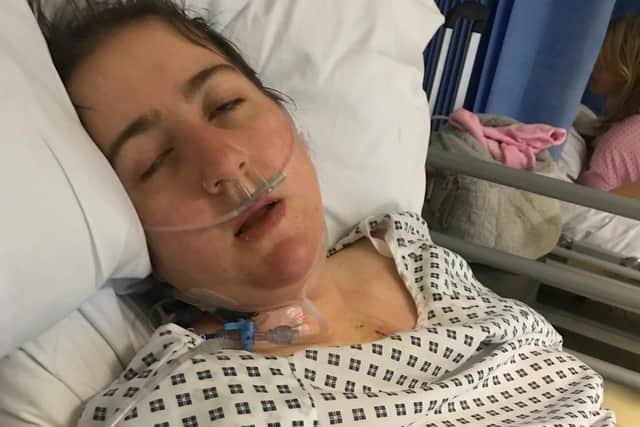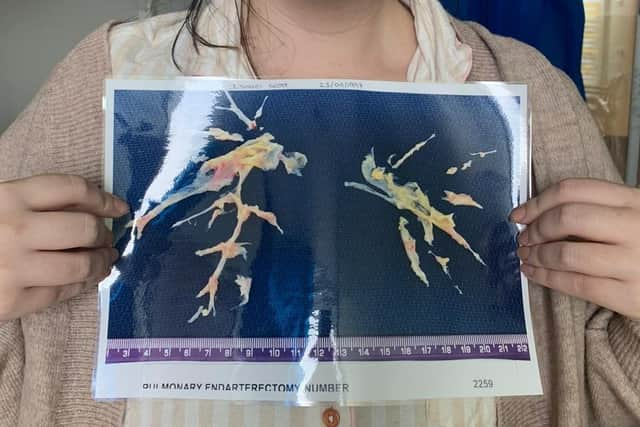York student has all blood drained from her body to save her life


Student Izzy Scott has relived the operation in which she technically ‘died’ in order to save her life.
Izzy, 23, a student from Heslington near York, had to undergo the extreme operation to remove clots from her lungs.
Advertisement
Hide AdAdvertisement
Hide AdShe was diagnosed with pulmonary hypertension (PH) in December last year.


The life-shortening disease, which affects just 8,000 people in the UK, causes high pressure in the pulmonary arteries – the blood vessels connecting the heart and lungs.
Izzy had a rare type of PH called chronic thromboembolic pulmonary hypertension (CTEPH), caused by a build-up of blood clots and scarring in the pulmonary arteries.
Just 400 people in the UK have this type of PH.
She is sharing her story in support of PH Awareness Week, which takes place this week (November 2-8) and has been organised by the Pulmonary Hypertension Association (PHA UK), a Sheffield-based charity that works nationally to support adults and children with the condition.


Advertisement
Hide AdAdvertisement
Hide AdIn August this year, Izzy went under went major surgery to clear the clots at Royal Papworth Hospital in Cambridge. It is the only place in the UK that performs the operation, which is known as a pulmonary endarterectomy.
Izzy’s life-saving operation involved surgeons draining her body of all blood to clear the clots in her arteries and lowering her body temperature by half - meaning she was technically dead.
After the clots had been removed, the blood was refilled and her temperature increased, effectively bringing her back to life.
“I had time to come to terms with what would happen during the operation but because of coronavirus visiting restrictions, I was totally alone,” says Izzy.
Advertisement
Hide AdAdvertisement
Hide Ad“I was on my own in the hospital for three days before the surgery and it was really hard thinking that if I didn’t wake up, the last conversation with my family would have been via Face Time.”
Izzy stayed in hospital for three weeks following her operation, due to complications from a brain bleed.
She is now recovering at home with her parents.
Izzy, who is in her third year of studying a theatre degree at the University of York, wants to help other people understand the condition so they don’t have to wait as long as her for a diagnosis.
“It took me a year to get my diagnosis of CTEPH because my doctor had no idea what it was”, says Izzy.
Advertisement
Hide AdAdvertisement
Hide Ad“I was told it was asthma, and then anxiety, and all that time I was struggling to walk and couldn’t socialise. It was like I lost a year of my life.”
As well as severe breathlessness, Izzy suffered with chest pain and severe water retention – all common symptoms of pulmonary hypertension.
Her lips also turned blue, because oxygen was unable to make its way around her body, and at one point she struggled even to put on her socks.
After becoming so ill she was unable to leave the house, Izzy was eventually admitted to York Hospital and then transferred to the Royal Hallamshire Hospital in Sheffield, where she received her diagnosis of CTEPH in December last year.
Advertisement
Hide AdAdvertisement
Hide AdThe Sheffield Pulmonary Vascular Disease Unit (SPVDU), based within the Hallamshire, is one of only nine specialist PH treatment centres in the UK.
“It was frightening knowing there was something wrong but not knowing what it was, so it was a relief to finally get a diagnosis. But I had never heard of CTEPH and it was scary,” says Izzy.
“I feel so different already. I can go for walks without stopping and make it to the top of the stairs. It’s insane how much better I can breathe now.
“I want to raise awareness of CTEPH because I had no idea of what it was before it happened to me and young people especially are not always aware of what could happen. It’s a complicated condition to explain to people.
Advertisement
Hide AdAdvertisement
Hide Ad“I am always wondering how different things may have been if it had been detected earlier. Would it have got to the point of needing surgery?
“I went through a year of going back and forth with my GP and even after diagnosis I still encounter medical professionals who don’t know what it is. I understand it’s rare, but it can kill people. Ultimately, my operation saved my life.”
Iain Armstrong, nurse consultant at the Sheffield Pulmonary Vascular Disease Unit and chair of the PHA UK, said: “Pulmonary hypertension is very rare, and only 2,500 people have the type that Izzy was diagnosed with.
“We hear too many stories of people waiting months and even years for a diagnosis, and because PH is an ‘invisible’ illness, it can be very challenging to live with.
Advertisement
Hide AdAdvertisement
Hide Ad“We’re grateful to Izzy for sharing her story and we hope it makes a difference.”
CTEPH is the only type of pulmonary hypertension that may be cured or reduced via an operation.
Other types are treated with drug therapy which improves quality of life, but there is no cure. Some people with the disease undergo a lung and /or heart transplant.
The Pulmonary Hypertension Association (PHA UK) is based in Chapeltown, Sheffield.
To find out more about pulmonary hypertension or get involved with PH Awareness Week visit www.phauk.org. Search #PHWeek20 and #RareButThere on social media.